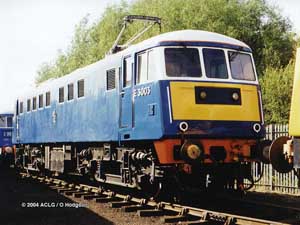|
|
In 1955, the British Transport Commission (BTC) launched a Modernisation Plan for Britain's railways. Key to the plan was the eradication of steam and the rapid electrification of key routes throughout the British Isles. Thousands of miles of main line, suburban routes and even country byways were earmarked for electrification using overhead wires. At the time the standard overhead system was 1500V DC, pioneered by the NER and developed by the LNER. It was used in BR days between Manchester and Sheffield, on the Woodhead route, from Manchester to Altrincham on the MSJ&A suburban route, and on the London Liverpool Street to Shenfield line.
The West Coast Main Line (WCML) from London to Birmingham, Liverpool and Manchester was chosen to be the first long distance route electrified, however, in 1956 the BTC decided to adopt a new overhead wire system of 25,000 V AC. This system, which promised construction, maintenance and efficiency savings over the 1500V DC system, was chosen following extensive trials in France, despite the existence of several DC equipped routes in the UK. A comparitive study at the time suggested that the costs of re-equipping the Shenfield route would be more than outweighed by the savings offered nationally by adopting the AC system. There may also have been political reasons for adopting AC, particularly to encourage British locomotive manufacturers to gain experience with the new technology, thus generating export orders. In any event, these manufacturers were given orders for 100 'prototype' locomotives, in five different designs, for use on the first section of the electrified WCML.
The first stretch of the WCML equipped with the 25 kV supply was the Styal line, a loop off the Manchester branch of the WCML, avoiding Stockport. This was energised in 1958, long before any of the production locomotives were ready for use. For driver training purposes, a Western Region Gas Turbine test locomotive (18100) was converted into an electric locomotive (E1000 - later E2001) and put to use on test trains on this line.
A year later, in November 1959, the first AL1 (Class 81), E3001, was delivered, to be followed over the next four years by a further 99 locomotives from Classes AL1, AL2, AL3, AL4 and AL5.
These five classes were built to a standard specification laid out by the British Transport Commission, who dictated wheel arrangements, weights, performance, overall styling and cab layouts; but each manufacturer was left to fulfill the specification as they saw fit. This resulted in five quite distinct locomotive designs, particularly on the insides, despite a family resemblance to the exterior.
All five classes were built with dual-voltage capability (25 kV AC and 6.25 kV AC for areas where sufficient clearance for 25 kV wires was thought to be unavailable) - in the event the whole West Coast electrification was carried out at 25 kV, and the 6.25 kV changeover gear built into the transformer was never used beyond testing. The locomotives were fitted with two pantographs from new, both feeding a common supply line to the transformer, although only one pantograph (usually the trailing one) was used at any one time. Although it was initially thought that the trailing pantograph offered better wire-contact performance, in practice there was little difference whichever pantograph was used, and all locos eventually had one pantograph removed (from the No.1 end) as an economy measure.
Electrification through from Manchester to Crewe was completed in time for a public launch on 12 September 1960, with the route from Crewe to Liverpool following in 1961. Over the next few years the wires gradually extended south, first to Rugby and eventually, in 1965 to Birmingham and London Euston, when the second generation of AC locomotives began to appear.
 E3003/81002 at Barrow Hill
E3003/81002 at Barrow Hill